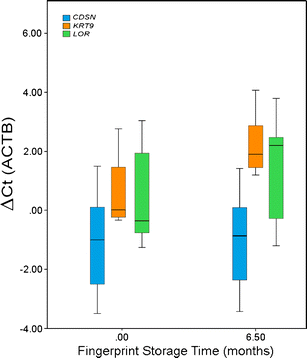mRNA-based skin identification for forensic applications
- PMID: 21221983
- PMCID: PMC3046345
- DOI: 10.1007/s00414-010-0545-2
mRNA-based skin identification for forensic applications
Abstract
Although the identification of human skin cells is of important relevance in many forensic cases, there is currently no reliable method available. Here, we present a highly specific and sensitive messenger RNA (mRNA) approach for skin identification, meeting the key requirements in forensic analyses. We examined 11 candidate genes with skin-specific expression, as ascertained from expression databases and the literature, as well as five candidate reference genes ascertained from previous studies, in skin samples and in other forensically relevant tissues. We identified mRNA transcripts from three genes CDSN, LOR and KRT9, showing strong over-expression in skin samples relative to samples from forensic body fluids, making them suitable markers for skin identification. Out of the candidate reference genes tested, only ACTB showed similarly high expression in skin and body-fluid samples, providing a suitable reference marker for quantitative real-time PCR (qPCR) analysis of skin. Analyses of palmar and thumbprint skin samples indicate that our qPCR approach for the three skin-targeted mRNA markers, as well as the reference mRNA marker ACTB, is highly sensitive, allowing successful detection of minute amounts of skin material including full, half and quarter thumbprints, albeit with decreased success in decreasing print material. Furthermore, thumbprints stored for 6.5 months provided similar results relative to freshly analysed samples implying reasonable time-wise stability of the three skin-targeted mRNAs as well as the ACTB reference mRNA. Our study represents the first attempt towards reliable mRNA-based skin identification in forensic applications with particular relevance for future trace/touched object analyses in forensic case work. Although the approach for skin identification introduced here can be informative when applied on its own, we recommend for increased reliability the integration of (one or more of) the skin-targeted mRNA markers presented here into multiplex assays additionally including mRNA markers targeting alternative cell types expected in forensic samples.
Figures




References
-
- Virkler K, Lednev IK. Analysis of body fluids for forensic purposes: from laboratory testing to non-destructive rapid confirmatory identification at a crime scene. Forensic Sci Int. 2009;188:1–17. - PubMed
-
- Bauer M, Patzelt D. Evaluation of mRNA markers for the identification of menstrual blood. J Forensic Sci. 2002;47:1278–1282. - PubMed
-
- Fleming RI, Harbison S. The development of a mRNA multiplex RT-PCR assay for the definitive identification of body fluids. Forensic Sci Int Genet. 2010;4:244–256. - PubMed
-
- Haas C, Klesser B, Maake C, Bär W, Kratzer A. mRNA profiling for body fluid identification by reverse transcription endpoint PCR and realtime PCR. Forensic Sci Int Genet. 2009;3:80–88. - PubMed
-
- Juusola J, Ballantyne J. Messenger RNA profiling: a prototype method to supplant conventional methods for body fluid identification. Forensic Sci Int. 2003;135:85–96. - PubMed
Publication types
MeSH terms
Substances
LinkOut - more resources
Full Text Sources
Other Literature Sources
Miscellaneous

